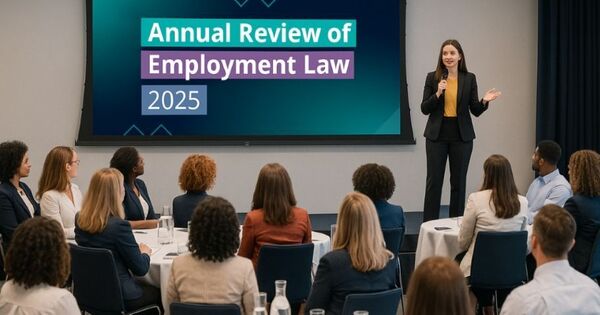Seamus McGranaghan qualified as a Solicitor in O'Reilly Stewart Solicitors in 2003 and is an experienced Commercial Lawyer dealing with employment, commercial and education cases.
He has experience in the Industrial Tribunal representing both Claimants and Respondents and has provided seminars in relation to particular areas of employment law. Seamus is the only member of the Education and Law Association in Northern Ireland. He specialises in advising schools and colleges on policy matters, employment issues and student welfare. He is also responsible for the Education Law Quarterly Review.
In addition to having contributed at Legal Island’s Education Updates since 2010, Seamus in association with Legal Island provides a live “Employment Law @ 11” webinar on the first Friday of each month, dealing with all aspects of Employment law affecting Northern Irish employers.

Restructuring with Respect: Getting It Right
With rising concerns around “quiet redundancies”, AI disruption, and economic uncertainty, many employees are feeling unsettled.
In this timely webinar, Employment Law at 11 regular Seamus McGranaghan of O’Reilly Stewart Solicitors and special guest Denise Collins of ForeBee Consulting explore how to handle redundancy lawfully and respectfully—from fair processes and communication, to supporting those affected and retaining trust among those who stay.
A practical session for anyone involved in difficult workforce decisions.
Please note that the employment law matters discussed in this webinar apply primarily to Northern Ireland.
Transcript to follow:
Christine: Good morning, everyone, and welcome to Employment Law at 11, sponsored by MCS Group. My name is Christine Quinn, I'm from Legal-Island, and I'm facilitating today's session.
So today, we're discussing an important issue: restructuring with respect. We want to help you get it right. So with rising concerns about quiet redundancies, AI disruption, and ongoing economic uncertainty, many employees are feeling unsettled. Workplace restructuring is a sensitive area that requires balancing legal compliance on one hand with empathy and respect on the other. So how organisations handle redundancy processes can have lasting impacts on employee morale, trust, and the overall workplace culture.
We're fortunate to have two experts with us today. Seamus and I are joined by Denise Collins from ForeBee Consulting. You're very welcome, Denise.
Denise: Thank you, Christine.
Christine: Denise has a great background. She has been working in HR for more than 25 years. Her background is she has a PhD from Queen's University as a chemist, but, in her words, she fell into HR early on in her career. She's worked for GlaxoSmithKline in London, and she returned to Ireland to work for Coca-Cola, and more recently she worked for Norbrook Laboratories. And she's now set up her own consultancy, ForeBee Consultancy. So she's more than qualified to share her expertise with us this morning, and we're delighted to have her.
If you want to know a little bit more about Denise and ForeBee Consulting, there are some details attached to the webinar.
So please do check that out.
Seamus is going to be covering the legal framework for fair processes and sharing a few of the legal pitfalls and how to avoid them this morning. Denise is going to focus on communication, support for the affected employees, and maintaining trust within the organisation.
So as always, please feel free to submit your questions at any time using the Q&A feature, and I'll make sure to put them to Seamus and Denise as and when appropriate.
Any documents that are mentioned by either of our speakers this morning are attached to the webinar, so please do have a look at those as well.
So thanks, as always, to our sponsors, MCS Group. MCS helps people find careers that match their skill sets perfectly as well as supporting employers to build high-performing businesses by connecting them with the most talented candidates in the market. If you're interested in finding out how MCS can help you, head to www.mcsgroup.jobs.
Now, as always, on Employment Law 11, we want to pick your brains a little bit. We're going to do some polls. I am unassumingly asking you to help me plan the Annual Review of Employment Law at Legal-Island. So, can you please select any of these issues that apply to you that you think we should be talking about, that you'd be interested in? We have got toxic workplaces, we've got cybersecurity and cyberattacks there, personal injury claims for mental health in the workplace, managing multi-job workers, and also employee fraud. So, if you could click on those, any that you're interested in us talking about, any that are affecting you at the moment, that would be great.
I can see you're all voting, which is extremely helpful. Thank you very much. Great. So, Gosia, let's have a look at what our results are. We've got toxic workplaces well out in front there, 73%, Seamus. Maybe Donald and Elon have been working in a bit of a toxic workplace, and it's all starting to come out in the wash now. Is everyone experiencing that, do you think?
Seamus: It looks that way at 73%, yeah. I mean, it's always an interesting one, a toxic workplace. I think we do so much to try to iron issues out amongst employees, and particularly all of the different policies and procedures that we have now. But it's a classic one where there are difficulties that arise in the workplace, whether it is a non-performing employee that is having an impact on everybody else or, alternatively, a non-performing manager that is failing to manage properly in relation to staff.
It seems to be certainly, from everything I read anyway, one of the biggest factors as to why people leave their place of employment and move somewhere else. And so, it's always interesting to see.
There's always interest in those toxic workplace aspects of it. You're never not surprised by what comes along with it. But yeah, it's definitely up there with the popularity there. I can see that.
Christine: Brilliant. Thanks very much, Seamus.
If we move on to our next poll, please, Gosia. Again, I'm asking you which topic is most relevant to your workplace, and you can click on any that apply.
So, use of secret recordings in tribunal. I know we're seeing a lot of that at the moment, people with phones in their pockets during the disciplinary process.
We've also got exit conversations. Do you want to get rid of that person? How do you do it legally?
Stress and burnout in the workplace. Do you need an immigration update? Do you know enough about the changes in immigration law? Or would you like to hear a flexible working case study? So, a real-life example of a company that's doing it really well, what's worked, what hasn't worked, what benefits they're seeing, what issues they've encountered.
So, if you could please vote on that. I can see it's a bit more steady, although we are seeing stress and burnout taking the lead, which is . . . Everyone is having a bit of a rough time, I think. Yes, stress and burnout came out on top there with 71%, closely followed by the flexible work in the case study.
Denise, stress and burnout, it's always an issue, isn't it?
Denise: It is, and no surprise to see that coming out on top actually, Christine. And it links, I think, also back to the earlier poll there on toxic workplaces because I think a lot of the stress can come from the manager-employee relationship. So, you see a lot of that.
Grievances I have seen across a number of companies have been related to work-related stress, and absence is increasingly across the board coming from stress and burnout.
I think some of it has come from post-COVID. Everybody worked in a different way in COVID. Maybe now, and certainly in the Republic of Ireland probably more so than Northern Ireland, we're seeing employers requiring, shall I say, employees to spend more time back in the office. That is creating a different type of stress in terms of managing their personal life as well. And the whole burnout thing with less people in the workplace necessarily.
So, I'm not surprised to see that, and I think we will see more cases going forward actually on that topic as well.
Christine: Yeah. Brilliant, Denise. Thanks for your insights there.
Then we've just got a final poll. In Annual Review, we will be talking about AI in the workplace, so just want to get a bit of a feel for how you're dealing with AI. How are you approaching AI in relation to HR or learning and development in your training needs? So, are you reducing your reliance on external training using AI? Are you using it informally, but it hasn't replaced formal training? You're exploring AI, but you haven't integrated it into your R&D yet. Or you have a restriction or prohibit the use of AI.
If you could vote there, that would be helpful. I'm not going to put up those poll results. That is purely just a little bit of info gathering. Thank you very much, everybody, for voting.
Let's get things started. Seamus, if you'd like to kick us off with some examples of how legally we should be dealing with redundancies.
Seamus: Redundancy, I think, from my perspective as an employment lawyer and a solicitor, the redundancy aspect is always coming across the desk in some shape or form, whether it's through employers and businesses just wanting to restructure or reorganise or where there is sort of general downturn, or to operate their businesses as efficiently as they wish to do. There are legal entitlements for the employer and the business to do so. It's always a matter that is across the desk.
You do notice in economic trends and in response to how the economy is whether redundancies are up or down. And certainly, if I think back to the very start of COVID, there was a mad panic by employers, understandably so, because no one really knew before we were aware of furlough and government assistance and all the rest.
I think the first few weeks of March were really spent with this sort of catalogue of desires of employers over, "What are we going to do?" and, "There's a short way out here in terms of redundancy. What does that do for our company? How long is this COVID period going to last? How do we get our employees back if we need them? Can we look at short time working instead and pulling through everybody's contracts?" and all that sort of stuff.
You can see just where the economy goes up and down, where there are certain things that redundancies tend to rise. I don't have the tribunal figures, but I would suspect that the tribunal figures would be similar to that, or even probably better. Now would be the early conciliation applications that are received and the amount of redundancies that are received through there.
So, look, as I mentioned, I've been practising for over 20 years. Redundancies are always a tricky aspect to get right. There are very large and small loopholes that you can trip over. And if you're a solicitor or an HR adviser working through a redundancy process, there is so much that you need to be aware of and take on board.
One of the biggest problems I see with redundancy is where it's rushed. And we look at the LRA advice on handling redundancy, which is up in the materials there, and that was just reviewed in March 2024. It's excellent, and you'll see that redundancy shouldn't be a process where it is rushed or pushed through as quickly as possible.
I think that that's one of the nails in the coffin whenever you get a tribunal hearing. If there has been a rushed redundancy process, there'll be huge issues arising in relation to all of the potholes and loopholes that have been missed.
The general position on redundancy is always . . . I think the first point that you want to look at is "Why are we at a redundancy point? Is redundancy required? Is it genuine?" And I think from a legal perspective, certainly whenever I get a new case that comes across my desk, the first thing I think about would be, "Is this a genuine situation?"
And as I said, business, economics, and trade are the three sort of reasons as to why businesses would come around to redundancy. And again, they're entitled to operate as efficiently as possible. Businesses are there to make money. They're there to make profit. No one should shy away from that. That is the purpose and the function of a business. But in saying that, if you are coming to redundancy, you need to do it in a fair way.
Just briefly mentioned at the start, I remember having a tribunal case where I was acting on behalf of the respondent, down for our case management discussion as it was at the time, [inaudible 00:12:24]. And I remember one of the employment judges saying, "This is a one-of-one redundancy. Red flag is up. Suspicion is on. Why is there only one person being made redundant?"
Looking back on our polls, those exit strategies and exit discussions are maybe more aligned whenever it is a one-of-one. And we know that we have a different position in Northern Ireland than what they have in England as regards protected discussions and things like that.
But one-of-one redundancies are difficult, and you tend to fall outside the process a little bit because where you're working through a managed redundancy process, where there's a collective redundancy consultation period, you're working through a defined process as set out in the legislation and in the guidance. Where if it's a one-of-one redundancy, there's no strict time limit in relation to how you work through it. And those redundancies, I think, are always more difficult.
I think the key thing in relation to all of that, and maybe Denise will just pick up on this here, is the element of redundancy, if you are communicating well with your employees and you're open and transparent about your business with your employees, the employees should know when things are good and when things they're not so good.
It's that element of surprise. That's the big problem with redundancies and why things come off. The wheels come off at the very start because it's a shocker and people aren't aware.
So it is that aspect of we are in an era of businesses now reporting on their profits and their turnover and all those sorts of things. And then we have different bits and pieces like gender reporting. We don't have yet, but it's on the way. They all feed into all that kind of stuff. So, I think certainly there's an element where that element of shock and surprise needs to be managed early on.
Christine: Yeah. Denise, do you want to pick up on that? So how exactly do you start to sow the seeds before, I suppose, the more formal legal process kicks in?
Denise: I think that's a very, very important point, Seamus, that you made, is the whole element of surprise or shock. It will always be a shock even if employees can see it coming.
For me, and what I have seen in places I have worked, is as a leadership team or the senior executive, you're not planning this overnight. You're seeing this is on the horizon for several months. So that's where, to your point, Christine, I think as a business you need to sow the seeds.
In my experience . . . and we didn't do this, by the way, but don't come out one month and announce, "Bonuses for everybody", or a big hike in pay raises, and then two weeks later you're announcing a massive restructuring in the organisation and you're letting people go.
Immediately, you have lost the respect as a business of all of your employees, whether those that are impacted or those that will remain in the business. You're really behind the foot in all of that.
So, for me, sow those seeds early. Think consciously about what type of communication you normally do with your employees in your organisation and [inaudible 00:15:45].
I know, having done a major restructuring in Norbrook two years ago, that as a leadership team, we were actually concerned that it would be a massive shock to the organisation to do a big restructuring, because in the company's history they had never done a big restructuring before. We planned very well, and we thought through it.
But actually, when it came to the announcement, the employees told us themselves they didn't know why we hadn't done it months earlier, because they could see that they weren't busy on the work.
So, sow those seeds early. It doesn't make it emotionally easier, but it might make setting it slightly easier for the employees when it comes to that.
Christine: Yeah, it takes away that bad feeling, doesn't it? That, "Oh, that team is getting bonuses and now you're getting rid of us", and sort of the gossip and the chatter, I suppose. It settles that, doesn't it? Brilliant. Thanks very much, Denise.
Seamus, back to you with the legal to follow, I suppose.
Seamus: Yeah, I suppose ultimately when the decision has been made and before you're thinking about announcement, you really are looking to see what procedure you have in place.
Nowadays, we see even small employers with solid, good handbooks. They've invested in policies and procedures. So, the first thing you want to look at, and our favourite thing to talk about and say, Christine, is, "Where's the policy and procedure? Where is the redundancy policy and procedure? And how does the company go about making these redundancies?"
The LRA Code of Practice says clearly a formal policy is the best way to proceed in relation to it.
Again, Denise will be familiar with that aspect of before you start delving into the actual redundancy process that you're given an opportunity in terms of feedback. Feed into the policy and procedure. And certainly, if you're a unionised employer, you're engaging early course with your trade unions.
And maybe the policy and procedure that you have will need to be tweaked, it'll need amendments, or that you just simply don't have a policy and procedure, and you're creating one to work through that process.
I've done redundancies for small-scale businesses, young businesses, start-ups, and things like that where they don't have policies and procedures. What I do is I say, "Adopt the LRA guidance in relation to the redundancy process. That will keep you right. Share a copy of it with the employees and let them know that this is what you're using". In default, you can use that, but ultimately you do want to have your formal policy in place.
And it sort of moves us on, then, through to our consultation. The really probably important point is making sure that there is adequate consultation. There's a legal obligation to consult, whether you're making one person or five people.
The legal aspect will always hit in that if you are making less than 20, you don't have to do collective consultation, but if you're doing more than 20 employees over a 90-day period . . . It's a 30-day consultation period, but if it's over 100 employees, you're then in the 90-day consultation.
So, for the large-scale employers, maybe more so what Denise is familiar with, you're looking at a 90-day, close to a three-month period of consultation.
Always, the reminder is don't forget that if you're making any more than 20 people redundant, there is a legal obligation and a duty on you to file an HR1 form with the Northern Ireland Statistics and Research Agency.
And feeding into a little bit about what Denise will maybe say, again, you're alerting the government early course that there's a risk here of redundancy.
The form is quite a short form that you fill in, but what they do then is they think about, "Well, do we need to notify our local benefits offices if there's going to be a large-scale number of redundancies? Do we need to get people set up in relation to dealing and tackling this?"
And ultimately, really what you want to do is make sure that you're looking after the employees during that period of consultation and you're maybe going out to recruitment agents, going out to local job centres, and inviting them in to give presentations or advise the staff of what jobs might be available out there in the local community or beyond.
The consultation is really important. You're dealing with, in the consultation, the ways of avoiding the redundancies, reducing the number of employees that are to be made redundant, and then that aspect of reducing the effects of redundancies.
We've specific legislation in the Information and Consultation of Employee Regulations. They're the 2005 Northern Ireland regulations around consultation. And don't forget that it's just as important, even in a collective redundancy consultation process, that if someone wants to come and have a chat with you on an individual basis, do that. Open the door and have that aspect.
Christine: Brilliant. Denise, if we can just bring you in, it's a real balancing act, isn't it? Frequently, managers who are doing these consultations, they already know that Joe and Josephine Blogs are the underperformers in their team. They're probably going to be out. It's about balancing that. Keep schtum. Don't be giving away what may or may not happen once we've completed the consultation process. It's about kind of keeping your managers in check, but at the same time giving them the confidence. There's a process to follow. We're following it. Just stick to the script. Isn't that it, Denise?
Denise: A hundred percent, Christine. Your managers are critical to the redundancy process because they are the ones . . . As you say, they know it's Joe or Mary or whoever in their team that might be selected, because we don't know in theory through the process.
But for me, one of the critical things as an HR professional that you can do before you start the whole process is to work with your managers. It's to coach-train them.
And again, I've done this before where we've brought managers into a room before the announcement, because the managers are at the coalface, and actually helped them understand the economic or whatever the reasons were, but then go down into the whole topic of today, restructuring with respect, which is how to have those difficult conversations, how to listen and treat their teams as humans.
The worst thing I think a manager can do is just be ticking the box, right? "I have to do this consultation today at 10:00, but my next one is at 10:30". It's just a matter of ticking off "I've been through these 10 different consultation meetings". Those employees won't be treated with respect if a manager does that.
So, train them, help them to understand how to have a difficult conversation, help them to understand that it's okay to say, "I don't know". They don't need to be armed with every single answer about the business or about the redundancy, the legal process itself either.
A story. I won't give away the company that I worked in, but we had collective consultation. Actually, we were down at the stage of individual meetings with those that were at risk or to be selected. A manager and an HR professional were in the meeting with the employee, and the employee challenged their redundancy illustration, said it wasn't right.
The manager in their wisdom panicked, took their phone out, got the calculator out, and recalculated statutory redundancy. That manager didn't know at 41 years of age whether it was a week or a week and a half per year of service, and it was capped at [inaudible 00:24:08] or whatever, and proceeded to tell the employee what he thought that person's redundancy should be. And of course, it was wrong.
So [inaudible 00:24:18] sharing that story. The manager wanted to be helpful, but actually it created so much unintended consequences. So, train them within an inch of their lives, but be there as HR to support them and guide them through the way, because you know the process and you're trying to support them in that.
Just one other thing to add to what Seamus was talking about. You're right, obviously, Seamus. You're the legal expert. Under 20, there's no need for collective consultation. I think if you have time and you want to do it fully and respectfully, I think you should do it anyway.
I know there's no legal requirement to do it, but again, you want to bring your employees with you, particularly those that are staying, and show that no matter whether it's a few, 30, or over 100 . . . we won't talk about "the one" . . . you should treat everybody with lots of respect and do it similarly.
Christine: Brilliant. Thanks, Denise. I actually know a bit of a nightmare story about not treating people as individuals. There was a manager who was having to call in 25 people and tell them that they'd been selected for redundancy. It was the end of the process. "Sorry, this is happening".
And by the end of the day, he realised that he'd actually made 26 people redundant and not 25. He'd actually had one person in twice because he was literally just . . . So, some poor person was sacked twice in the same day because the manager was just working down a list.
I mean, that is an absolute nightmare scenario. It shouldn't happen, and that manager was not treating people as individuals. It was literally just "next, next", and that was a horrible situation to be in.
Seamus, back to you.
Seamus: Yeah, we sort of touched there on the selection criteria, and there's lots around consultation. One of the real difficult bits that I always come across is where you don't have a trade union involved in the business, you're making more than 20 people redundant, and you have the whole employee representative elections to do.
And at times, if your business, whether it's factory-based or what it is, trying to explain that process to the employees about elections, what it means, how it facilitates, who would they pick, and all those sorts of things, it's really tricky and difficult stuff. I feel that there's definitely a shortage of guidance.
I've been through it and done it three or four times throughout the past couple of years, and it is where you're sort of . . . You're on tenterhooks as to whether or not this is going to work.
It's great if you have some kind of influence team or employee representative team already in place in a non-unionised business that you could look and see if that would work as regards the consultation. But just to flag up that that's a difficulty, and I think we could be doing a little bit more advice in and around that.
But moving on, the next thing is really the selection criteria. From a legal perspective, that's one of the biggies that you see coming through in tribunal hearings. And it's where someone puts their head above the parapet and says, "Look, I feel I've been unfairly selected here", or, "I'm not in the right pool", or "My selection has been unfair".
We know that redundancy is one of the fair reasons to terminate employment. But the unfair dismissal claims through the Article 126 of the Employment Rights Order, and that fair dismissal redundancy is set out in Article 132(2)(c) of the Employment Rights Order, where redundancy is a fair way of doing it.
One of the cases there, it's an old case that we all hear about and talk about, and we always see it in ET3 response forms, the case of Polkey, or at the end of cases where we're saying, "We want a reduction".
Polkey is actually a 1988 case, and it said that in case of redundancy, "The employer will normally not act reasonably unless he warns and consults any employees affected, or their representative, adopts a fair basis to which to select for redundancy, and takes such steps as may be reasonable to avoid or minimise redundancy by redeployment within his own organisation". It's a really short net quote, but it touches really on all of the basics that we have for redundancy.
There's another case of Langston v Cranfield University. Again, a 1988 case. And it talks about "where an applicant complains of unfair dismissal by reason of redundancy, we think that it's implicit in that claim, absent agreement to the contrary between the parties, that the unfairness incorporates unfair selection, lack of consultation, and failure to seek alternative employment on the part of the employer". So those sort of being the three key aspects.
I suppose, ultimately, you will set up and establish selection criteria. You need to make sure that your selection criteria are not biased or that it's not discriminatory.
Years ago, I did a tribunal claim where there were four ladies that had been made redundant. They were four part-timers and they literally just went in and selected them on the basis that they were part-timers. And they brought claims on the basis of their part-time status and on the basis of sex discrimination, because ultimately, they were saying that because of their gender, they were more inclined to work on a part-time basis.
The case was ultimately reported in the "Irish Times". It was supported by the Equality Commission, and it was a Southern Irish company that were the employer that had business up here. So, it's always one in my mind when I look at selection criteria.
I suppose now we have such a diverse range of employees that you need to be careful that you're not causing any difficulties in and around your selection criteria itself. It's always the one, when you get to tribunal, that raises its head, and you think, "Are we covered here in relation to everything that we should have done?"
The other thing to mention is just obviously we have our statutory disciplinary and dismissal procedure. Again, Denise will probably touch on this in the sense that you must follow through on your basic procedures. You have to have your meeting, your decision issue in writing, and you have to offer the right of appeal. It's under the Employment Order 2003 and the 2004 regulations.
And there's, of course, the power of the tribunal to increase or decrease an award by between 10% to 50%. It's the compensatory award that they can increase. But it could be a substantial amount of money if you haven't followed through on that basic procedure. And when I say basic procedure, it is the very basic that any employer should be following.
Now, there's a different route if you're working through a unionised or a collective consultation process, but I don't think that allows you to hide behind it. And again, it's about treating the employees appropriately and fairly.
Christine: Denise, I'll just bring you in now to touch on when you're creating selection criteria, how do you do that with empathy while making sure that you are following the rules, left with the right people, getting rid of the right people, etc.?
Denise: I think Gosia will put in the link there. There's a piece on my website around restructuring with respect and talks about this. Don't do redundancy to employees. Involve them in it. And I think that the consultation is really catered to that point, that question you're asking, Christine.
There's not one set of selection criteria that's going to fit right across the board if you have lots of different functions involved in a restructuring process. It comes back to the managers again. It's engaging those managers, looking at what are the requirements for the future, and then looking at those and trying to draft, that's the important word, your selection criteria around that.
Then it's about consulting either with your representatives, your trade union representatives or your individually elected representatives, to work through that.
And I would go so far as to say even though you have a trade union or elected representatives, and Seamus, you mentioned it earlier, if an employee wants to come and see you one-to-one, you open the door to them. So don't be afraid also of walking the employees, as well, through the selection criteria so they clearly understand.
They might not be comfortable because they might see that they are the weakest or they're going to be scored the lowest and might be at risk. But if they understand that it's fair, that you've thought it through, that they can see the rationale for it, they're more likely to be accepting of the situation.
So, with that engagement and talking, don't just say, "Here it is", and land it on the table. Have that too, but listen, take feedback. Take feedback in if it's appropriate. Obviously, you're not going to do everything that they want to say but listen to them and think about that.
The more you communicate, the more open and transparent . . . I think you've used those words, Seamus and Christine . . . the easier it's going to be for everybody involved.
Christine: Brilliant. Yeah, I think I've dealt with a lot where businesses just want to get it over with. They want to rip the Band-Aid off a bit because they feel so uncomfortable with it. That's where you're going to trip yourself up, isn't it?
Denise: Correct. And again, I know we're bouncing back on each other, Seamus, but you mentioned it earlier as well in tribunal cases, is that it felt like it was rushed. These are human beings. These are people's livelihoods that we're talking about here.
In some cases, and I've dealt with them, somebody has only ever worked in that company. And in fact, their sibling, their child, their nephew, their niece are also in the company, and they might also be at risk of redundancy. It's a massive thing for them to leave and not know whether tomorrow they're going to come in.
So don't rush it, and support them, and give them those supports. Again, Seamus mentioned it earlier, but that's another key thing for me. You have your process, that there are no shortcomings here. You must follow your process. But the support doesn't stop when you issue that "you are dismissed by reason of redundancy" letter. You should, as a good employer and a respectful employer, support the employees for their next stage.
And you mentioned it, Seamus, through your HR1, etc., you're informing the different agencies that there is at risk of redundancy in all those people, if it's a large scale. They will get on to you.
There's a great fact sheet from the Department for Communities you can give out.
Go to recruitment agencies that you use. Get them on-site. Help employees with CV writing. They mightn't have had to write a CV in years. Take them through mock interviews.
Your recruitment agency that you work with will only be too delighted to come on-site and help you, because they're going to see good candidates that they can place elsewhere. So, it's a win-win situation.
And it doesn't have to cost a single huge amount of money to provide that support. You have it in your own HR team, you have it in other managers, and there's full support out there as well. Utilise that.
Christine: Brilliant. Thanks. I think it's coming through loud and clear it's about the individuals. As you said, it doesn't have to cost a lot to do it and to show that, I think.
Seamus, I think you have some case law that you were going to tell us about that was some sort of cautionary tales?
Seamus: Well, I suppose just before that I wanted to mention the other big aspect in relation to the redundancy, which is the redeployment aspect.
So we know that we have to go through the consultation aspect, but also there is the redeployment and the various bits and pieces around offering alternative employment to employees, looking at the trial period in relation to allowing them to try the role essentially and to see if they're happy with it, and again, those aspects of time off to look for new work and training, those things that are enshrined within the guidance and the legislation.
Ultimately, there tends to always be a process where redundancies are announced, and there's a throw-out to, "Would anyone like to volunteer?" And it may be that you have a generous voluntary severance process that you can look at and to try to encourage.
And you would see that with maybe . . . I think traditionally over the last lot of years, a lot of the banks with the closures of branches and things like that, we've seen as an example of that where they will look at voluntary severance schemes. They'll make an offer of a huge increase or a significant increase on what you would get on a statutory basis and a redundancy to it.
It's that aspect of if you're looking at your economy within your business and you are saying, "Are we in a position to offer voluntary redundancies, and will that ultimately avoid the need for us to go down a compulsory redundancy rate?"
So, there are different steps. I know we're trying to keep a sort of straight line here of getting A to Z in relation to the process, but you can tell from this morning that there are so many different factors that you have to include and think about in relation to it.
The redeployment aspect is one that I would see that will regularly trip businesses and employers up in the tribunal also. And particularly around this aspect of suitable alternative employment and what that is and what it looks like for other people.
I suppose the other really important aspect is don't forget about the entitlements. And I think as soon and as early as you can, let the employees know what their entitlements are going to be.
We're talking here about if they are made redundant, what is the notice that's going to be provided? Do we need to look at their contracts? Are we looking at a period where we're going to look at PILON instead of having employees work their notice? That lets the employee out earlier and allows them to start alternative work earlier.
Or is it a situation that perhaps we're running down an element of the business and we require the business to keep its employees until a certain date? What is the pay going to be like until the termination date? Are we still going to enjoy our pay and benefits that we receive until the termination date?
And what will my redundancy package look like? It should include your notice period or your PILON, your salary to your termination date, your accrued holidays, and entitlement determination.
Some employers will say, "No, we do require you to work your notice period, and we're going to also ask you to use your holidays that you've accrued within that notice period as well". Sometimes the business just can't support any other way. That's just where things have got to.
And then looking at what the redundancy pay is going to be, bringing it back to the contract. What does the contract say about redundancy and redundancy pay? Are we going to be making a statutory redundancy payment, and what does that look like?
It's probably really easy for you and I and Denise to go on to figure out what the statutory redundancy payment is. And it is quite easy whenever there's a great website through dot-gov and [inaudible 00:41:28] you can do it through.
But not everybody knows that, and it's tricky and it's complex, particularly whenever you get around what the weekly cap is, what the cap is in relation to your number of years' service, and then the age aspects of above 41 and below 41. And then is there going to be any enhancement that's going to be provided by the employer? Then the other entitlement in relation to it is "What about my bonus?" or "If I have shares in the company, what happens to all of that as I'm leaving?"
I think it's really good from a respectfulness aspect to let the employee know early course what that's going to . . . They need to plan. They need to know what they're going to have to factor in as regards "What is the length of time that this money is going to do me until I am in difficulties with my mortgage payments?" and stuff like that. So, I think that it really is about that.
And I think that if you are in a position of looking at enhancements, think about Labour Relations Agency and think about the early conciliation process or non-ET1 agreements, where you are a business that has been supportive and is helping the employees as much as you possibly can, and you're helping them out.
There can be, again, from Denise's side of things, that respectfulness, that mutual understanding, to say, "Well, look, we're going to enhance it, but we do require you to sign an agreement here because we want a clean break. We want it good for you, and we want our business to be clean moving forward so we know where we stand".
Case law that I was referring to, Christine, was more to do with the sort of unfair selection aspect of it and some of the legislation that I talked on. But I'll let Denise close out just on those other aspects of respectfulness and where you get to at the redundancy aspect.
Christine: Yeah, Denise, you're a big advocate for involving the LRA, aren't you? Maybe you could tell us a bit about that.
Denise: Yeah, I am. When I was in Norbrook Laboratories, it was a non-unionised environment. And as I said earlier, first time in the company's 55-year history that they did an across-the-board restructuring. So, you can imagine employees were very nervous.
One of the biggest positives from the employees who were within the pools of redundancy was the involvement of the LRA. The LRA came in, they explained this the same as we did, thankfully, as to what the redundancy process is, what the employer had to do.
It was external verification for the employees that we as a company were treating them properly and legally properly. And then because we did, in that particular redundancy situation, offer an enhanced package, we went through the whole non-ET1 process.
LRA were excellent. They provided as many people as we needed on the day. They went through the detailed calculations. Well, they had them in advance, but the detailed calculations with everyone. So, everybody knew that we weren't short-changing them and that it was all done properly. It was externally verified, as I said, so they knew that. And it was a clean break that Seamus mentioned there as well. So, I would strongly advocate for the involvement of the LRA.
The other thing I would say is if you can . . . I know it's not always possible, but if you can, I would be a believer in offering PILON, pay in lieu of notice. The reason being, and we haven't touched on this earlier, but you have another cohort of employees, which are those that are not impacted, and they're going to be left behind.
They're going to go through a similar but different stage of emotions than those that are impacted. And you really want to be able to move the business forward, as hard as it is, with those employees going forward. You don't want people leaving in dribs and drabs or working out their notice. Their mind is not going to be on the business.
So, don't forget about that other group of employees as well. And if possible, move forward. But the use of external bodies, absolutely a believer in it.
Christine: Brilliant. Thanks, Denise. And very quickly, can I get, Seamus, your top two takeaways for people today?"
Seamus: Yeah, I think the first is policy and procedure. It's always going to be that. I beat that drum, Christine, every time. Policy and procedure. You'll likely fall down if you get the tribunal case and you don't have a policy and procedure that you've been following.
You can look at the Labour Relations Agency's advice on handling redundancies, and my view would be that's a solid blueprint that you should be following through.
And the second, I think, is just in relation to your consultation. By far, I think it's the biggest grievance that employees will have, that they feel that they weren't properly consulted in respect. It's this aspect, "Yeah, they met with me twice. The meetings were 10 minutes. Somebody took a note of them. I got a copy of it. We didn't really discuss anything about what my suggestions were to avoid. It was a tick-the-box exercise", as you mentioned. Your consultation will be examined by the tribunal panel as to how you worked through on that.
There are lots of other bits and pieces to it, but I think those two would be the main ones of jump out at me. You need to have a policy and procedure, and if you have a good policy and your consultation should follow through automatically as a result of it. So those are my two takeaways.
Christine: Brilliant. Thanks, Seamus. And what about you, Denise? What are your top two takeaways?
Denise: Probably no surprise either for me. So how you treat the employees is so important. That will have significant reverberations amongst those employees themselves, those who leave. Those who stay, they're watching on the sidelines how you're treating those employees, because that's the culture of the organisation going forward.
It's a broader community. The people leaving are going out into that wider community. They're going, "This is how I was treated by my company". Future new hires, they'll know too.
So be human, be authentic, be open and transparent, and provide that support beyond the dismissal letter. Help them set up the future.
And my second point, which I don't think will be a surprise either, is prepare your managers. Coach them, tell them it's okay to say no, go through FAQs with them if necessary, and practise those difficult conversations, and for them as well as HR to be open and visible throughout the process.
Christine: Brilliant. Thank you very much. Thank you both. I really enjoyed that. Apologies that we have overrun by a few minutes, everyone. Thanks for bearing with us. But thank you both to Denise and Seamus.
Denise: Thank you.
Christine: Let me see. First things first, earlier on I mentioned that I was picking your brains because I'm planning the Annual Review of Employment Law. So it's no surprise that I am going to tell you that it's back once again in hybrid format. Join us for a dynamic day packed with learning, networking, and inspiration delivered by renowned employment law experts and HR specialists.
Our first speakers have been announced. There's a link in the chat that you can have a look at. You'll be pleased to know that Seamus and I will be there live and in person for our first-ever Employment Law at 11 live. All the cool podcasts go on tour, so that's exactly what we're doing. It'll be lovely to see you there either in person or online, of course.
If you miss us in the meantime, you can always catch up with Employment Law at 11 on our podcast on Amazon Music, Spotify, and Apple Music.
And of course, we are all available to contact on LinkedIn. There's Seamus, there's me, there's Denise. Please do reach out to us. It would be lovely to hear from you.
But in the meantime, please have a lovely weekend, have an enjoyable rest of Friday, and thank you, everyone, for joining us. See you again.
Sponsored by:
Continue reading
We help hundreds of people like you understand how the latest changes in employment law impact your business.
Please log in to view the full article.
What you'll get:
- Help understand the ramifications of each important case from NI, GB and Europe
- Ensure your organisation's policies and procedures are fully compliant with NI law
- 24/7 access to all the content in the Legal Island Vault for research case law and HR issues
- Receive free preliminary advice on workplace issues from the employment team
Already a subscriber? Log in now or start a free trial
 AI Literacy Skills at Work: Safe, Ethical and Effective Use
AI Literacy Skills at Work: Safe, Ethical and Effective Use












